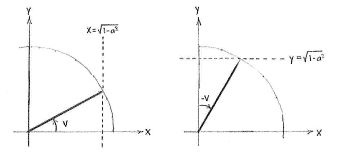Solution 4.3:3d
From Förberedande kurs i matematik 1
m (Lösning 4.3:3d moved to Solution 4.3:3d: Robot: moved page) |
|||
| Line 1: | Line 1: | ||
| - | {{ | + | The expression for the angle |
| - | < | + | <math>{\pi }/{2}\;-v</math> |
| - | {{ | + | differs from |
| + | <math>{\pi }/{2}\;</math> | ||
| + | by as much as | ||
| + | <math>-v\text{ }</math> | ||
| + | differs from | ||
| + | <math>0</math>. This means that | ||
| + | <math>{\pi }/{2}\;</math> | ||
| + | makes the same angle with the positive | ||
| + | <math>y</math> | ||
| + | -axis as | ||
| + | <math>-v\text{ }</math> | ||
| + | makes with the positive | ||
| + | <math>x</math> | ||
| + | -axis. | ||
| + | |||
| + | |||
[[Image:4_3_3_d.gif|center]] | [[Image:4_3_3_d.gif|center]] | ||
| + | |||
| + | Angle | ||
| + | <math>v</math> | ||
| + | angle | ||
| + | <math>\pi -v</math> | ||
| + | |||
| + | |||
| + | Therefore, the angle | ||
| + | <math>{\pi }/{2}\;-v</math> | ||
| + | has a | ||
| + | <math>y</math> | ||
| + | -coordinate which is equal to the | ||
| + | <math>x</math> | ||
| + | -coordinate for the angle | ||
| + | <math>v</math>, i.e. | ||
| + | |||
| + | |||
| + | <math>\sin \left( {\pi }/{2}\;-v \right)=\cos v</math> | ||
| + | |||
| + | |||
| + | and from exercise c, we know that | ||
| + | <math>\cos v=\sqrt{1-a^{2}}</math> | ||
| + | |||
| + | |||
| + | |||
| + | <math>\sin \left( \frac{\pi }{2}-v \right)=\sqrt{1-a^{2}}</math> | ||
Revision as of 11:11, 29 September 2008
The expression for the angle \displaystyle {\pi }/{2}\;-v differs from \displaystyle {\pi }/{2}\; by as much as \displaystyle -v\text{ } differs from \displaystyle 0. This means that \displaystyle {\pi }/{2}\; makes the same angle with the positive \displaystyle y -axis as \displaystyle -v\text{ } makes with the positive \displaystyle x -axis.
Angle \displaystyle v angle \displaystyle \pi -v
Therefore, the angle
\displaystyle {\pi }/{2}\;-v
has a
\displaystyle y
-coordinate which is equal to the
\displaystyle x
-coordinate for the angle
\displaystyle v, i.e.
\displaystyle \sin \left( {\pi }/{2}\;-v \right)=\cos v
and from exercise c, we know that
\displaystyle \cos v=\sqrt{1-a^{2}}
\displaystyle \sin \left( \frac{\pi }{2}-v \right)=\sqrt{1-a^{2}}

